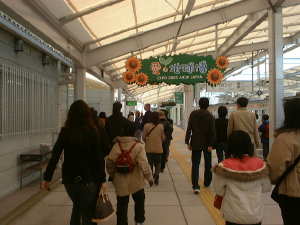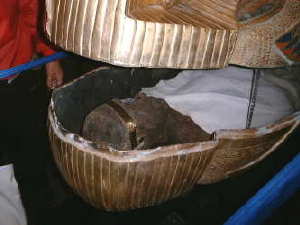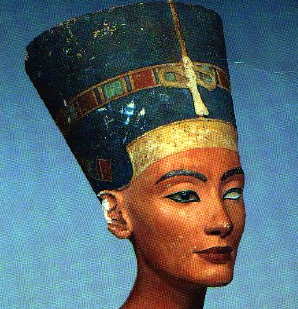|
 |
金山からJR中央線で万博八草まで出て、そこからリニモを利用した。左の画像はリニモの中。音が静かだが、これがリニモか・・・という感じで、たいした感動はない。それよりも、車内を撮影するのは勇気が要った。さりげなく、あくまでも窓外を撮っている振りしてシャッターをきったので、かなり不鮮明だ。さすがにリニモ利用者は多い。
今日はグローバル・コモンの3、4、5を中心に見学した。下調べをしなかったことと、あまりにも数多くの外国館に入ったことで、撮った写真と触れた具体的なものとが混乱している。目を閉じて記憶をたどってみるのだが、解読不能なものを無理に解読しているようなもので、錯乱状態に陥ってしまう。開催期間は長いのだから、徐々に更新していこうと思う。とりあえず、記憶にある写真だけをアップしてみる。 |
|
右は万博長久手会場駅。リニモから降りて、改札を済ませばすぐに北ゲートがある。リニモに乗っている人、この駅ホームを歩く人、みんながみんな万博行きか・・・物見高い人が多いものだ。そういう私も、物見高い人間の一人ということだ。
|

|
・エジプト館
|

|
「永遠のエジプト」のテーマを元に3000年前の古代エジプトの再現、という感じでエジプトで掘り出された多くの彫像や展示物が凄い。とりわけ「金」の輝きで魅了される。
左画像はエジプト館。エジプト文化を象徴する神話からの創造神の絵画がひときわ目を引く。束ねた形の柱もエジプト独特も物だろう。 |
|
右画像はツタンカーメンのミイラ。
実はこれはレプリカである。ツタンカーメンの死が考古学会で議論され、つい最近では、このミイラのCTスキャン検査の結果が、話題になっているてきただけに、さすがにこれを囲んで人垣が出来ていた。下の画像は棺の蓋の部分。

|

|
|
右の画像はオーストラリア友人(考古学者)から頂いたもので、ベルリンのエジプト博物館にある古代エジプトの三大美人と言われる「ネフェルティティ女王」の胸像。
考古学者にとって、研究の最たるものは古代エジプト。私のメールフレンドにオーストラリアの考古学者がいる。送られてきたメールのなかから「エジプトの考古学」についての一部を、彼に了解の上、原文のまま画像の下に載せておく。 |

|
I
like to write to you a little more about Egytian archaeology. This is
generally concentrated on tombs and temples, because most ancient town
sites are still occupied. They are generally in the damp river valley, where
perishable materials do not survive.
Burials were made in the desert, where the heat dries and preserves most things.
In the tombs are often found wooden artifacts of domestic activities,wall
carvings, and tools of all descriptions were buried with the dead.
The tomb of King Tutankhamen (who reigned 1334 to 1325 BC), was the
richest in content and craftsmanship. Most of its treasures are on
display in the Egyptian Museum, Cairo.
Hundreds of other tombs, from the 1st Dynasty onwards display the life
styles of the rich and poor alike. Near the royal tombs in the Valley of
the Kings stands a complete village where generations of tomb carvers
lived.
Numerous discarded notes, scribbled on broken pottery identify some of
the carvers and their houses, telling of their work, their food, and
their faith.
A chance find of some 400 clay tablets, written in Babylonian, drew
attention to the site in 1887. These tablets were letters concerning
relations with the Middle East from about 1375 to 1330 BC.
Excavation in the town uncovered workers cottages, which were better
than many modern laborers enjoy today and there were some fine villas
for the wealthy.
Mifue, look at the splendid art form of the attached picture of the head
of Queen Nefertiti what dates from 1355 BC. It is on display at the
museum in Berlin in the same condition as it was dicovered.
Studies of the great temples of El Karnak and Luxor have traced
successive stages of building and alterations.
Archaeologists have traced imports from Greece during the 15th to the
13th century BC of Mycenaean pottery at tombs of known Egyptian kings.
This knowledge is vital for the study of early Greek archaeology.
Early Greek traders visited Egypt and they left various relics. With
Alexander the Great's conquest, the Greek language began to replace the
Egyptian. Thousands of papyrus documents have been found near Birket
Qarun.
Other sites have yielded thousands more. These papyri record every
aspect of life in astonishing detail.(by Keith)
I am
very happy to see the mummie of Tutankhamun, he was ony a boy
when he died. It is still a mystery how he died, maybe he was
murdered? He was so young and not an important King, but he became
very famous when they found all the treasurers in his tomb.(by Keith)
|
![]()